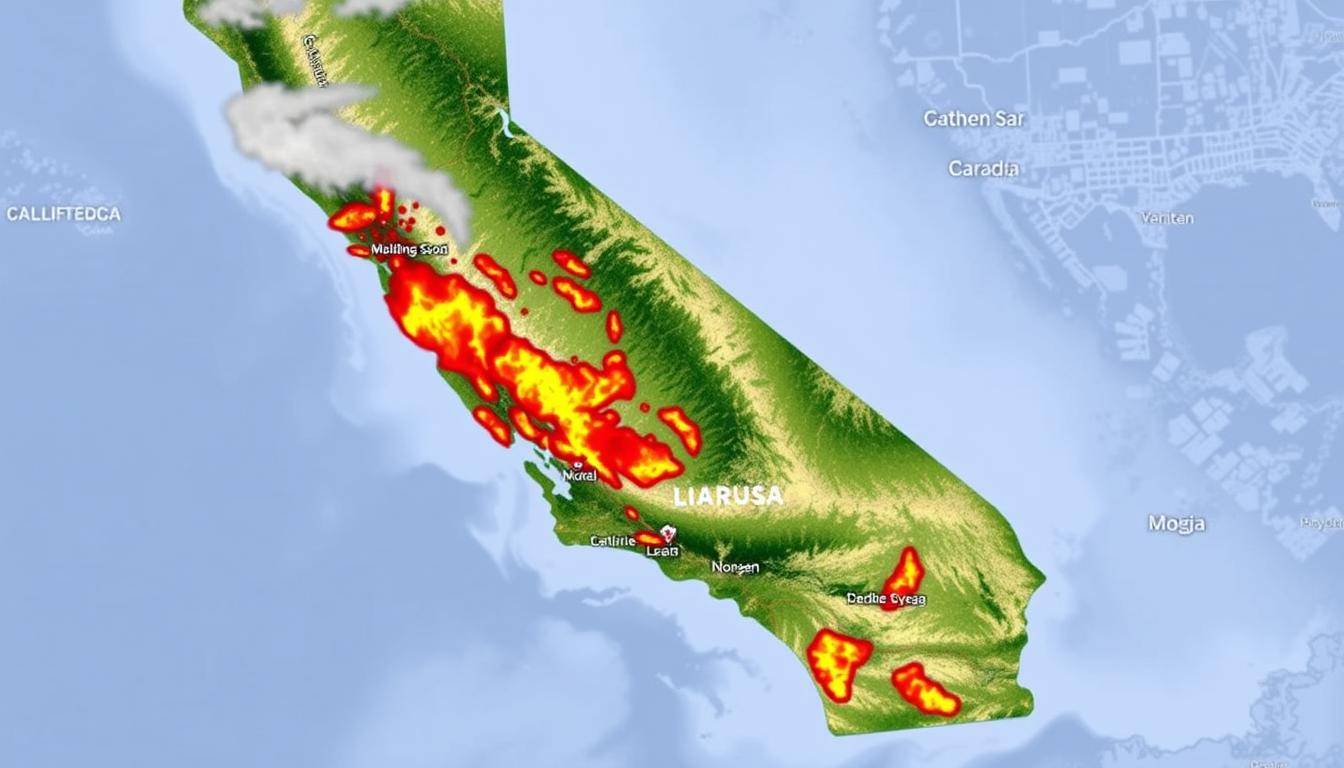The California fires map is a key tool for everyone in the state. It shows where wildfires are happening now. This is especially important during September and October, when fires are more common.
This wildfire map gives users the latest on fires. It helps communities get ready and react to emergencies.
Climate change makes wildfires worse. Knowing about an interactive fire map can help keep people safe. It’s great for finding out about evacuation zones or fire updates near you.
Using this tool can protect you and your family. Let’s look closer at how to stay safe from wildfires in California.
Key Takeaways
- The California fires map provides real-time updates on active wildfire locations.
- Understanding climate change impacts highlights the urgency of tracking wildfires.
- Interactive fire maps enhance community safety and preparedness efforts.
- Staying informed through these resources is vital during peak fire months.
- The map is accessible and necessary for both residents and officials alike.
- Effective use of the map can aid in timely evacuations and emergency response.
Understanding California’s Wildfire Risk
California is facing a growing wildfire risk. This is due to climate change, past fire patterns, and its geography. Knowing these factors helps us understand the dangers wildfires pose in the state.
The Impact of Climate Change
California’s climate is changing, with warmer temperatures and changing rain patterns. This makes wildfires more likely. California wildfires live updates show how these changes lead to more and bigger fires.
Historical Fire Patterns
Looking at past fires in California gives us clues. The year 2020 saw a record 8,648 wildfires. The Thomas Fire in 2017 was a big example of fires getting worse outside the usual season.
Geographic Vulnerabilities
California’s varied landscapes make it prone to wildfires. Southern California has long fire seasons, while Northern California sees shorter but intense fires. Using a wildfire tracking tool is key for those in high-risk areas to stay ready.
| Key Factors | Details |
|---|---|
| Climate Change | Rising temperatures and reduced rainfall contribute to longer dry seasons. |
| Historical Trends | Record high wildfire incidents in 2020 and notable past fires demonstrate increasing severity. |
| Geographic Risk | Diverse terrains and urban proximity to wildlands create unique vulnerabilities. |
Features of the California Fires Map
The California Fires Map is key for understanding wildfires in the state. It has features to keep people safe and informed. It offers interactive layers and real-time updates, making it easy for everyone to use.
Interactive Layers
The map has interactive layers for tracking fires, evacuation zones, and fire perimeters. Users can customize these layers to fit their needs. This helps them get the information they need quickly during emergencies.
Real-Time Updates
The map gets updated regularly with the latest fire information. It includes details like when fires started and evacuation orders. Even though it’s not live, the updates help people stay informed about local fires.
Accessibility for All Users
The map is designed to be easy for everyone to use, even those new to technology. Its simple interface lets anyone stay updated on wildfire dangers. This helps more people get ready for and respond to wildfires.
How to Use the California Fires Map
Learning how to use the california fire map today is key to making smart choices during wildfires. This interactive tool helps you check fire statuses, stay alert to dangers, and plan your actions. Here are the main steps to use this wildfire map well.
Step-by-Step Guide
First, find your location in the search bar or zoom in to your neighborhood. This lets you see fire incidents and their areas close to you. Then, use filters to pick what info you want, like recent fires, air quality, and evacuation paths.
Tips for Gathering Information
- Check the map often to stay current.
- Turn on notifications from the Frontline Wildfire Defense App for quick alerts.
- Get to know more resources linked to the map for all the details.
Interpreting the Map Symbols
Knowing the map symbols helps you understand the wildfire situation better. Fire zones are shown with icons, and colored overlays mark fire areas. These are key for seeing risks and planning your actions. Tools like MODIS and GEOMAC Wildland Fire Support Tool give you important data easily.
Emergency Preparedness and Safety
It’s key to be ready for wildfires if you live in an area prone to them. Having a good plan can help you stay safe. It’s important to have an evacuation plan, gather essential supplies, and know how to communicate during emergencies.
Creating an Evacuation Plan
Creating a detailed evacuation plan is essential for families. It should outline escape routes, meeting spots, and understand local fire risks. Using a wildfire tracking tool can help find the safest paths during fires. Many people don’t know the local evacuation routes, so it’s important to spread the word.
Essential Supplies Checklist
Having an emergency kit is a must. It should include:
- Non-perishable food
- Water (at least one gallon per person per day)
- First aid supplies
- Flashlights and batteries
- Important documents (like IDs and insurance papers)
Keep this list up to date. This way, families can quickly leave when needed, using the fire incident map for updates.
Communication During Emergencies
Having a communication plan is vital for safety. It should ensure everyone knows about evacuation orders and safety steps during wildfires. Keep a charged phone with emergency numbers saved. Talking about these plans often helps families act fast if wildfires come close.
Local Resources and Support Services
Millions of Californians are at risk from wildfires. It’s crucial to know about local resources and support services. These can help keep people safe and well during fires.
Emergency Services Contact Information
Having quick access to emergency services is key during wildfires. Here are important contact numbers:
| Service | Contact Number |
|---|---|
| FEMA | 1-800-621-3362 |
| American Red Cross | 1-800-RED-CROSS (1-800-733-2767) |
| CalFire (Fire Tracking) | Website: calfire.ca.gov |
| California 211 | 2-1-1 |
| ASPCA (Pet Assistance) | 1-800-738-9437 |
| Legal Assistance Hotline | 888-382-3406 |
| California Poison Control | 1-800-222-1222 |
Community Support Programs
Local programs help with pre-evacuation planning and recovery. Community groups work together to provide needed resources. You can find guides and services at local shelters and centers.
Mental Health Resources
Wildfires can deeply affect people’s mental health. Many organizations offer support for those impacted. These resources help people deal with the trauma of evacuations and losses.
Social service agencies provide counseling and support groups. They focus on building resilience and helping with recovery.
Latest Wildfire Statistics in California
California is facing a tough wildfire season. The number of fires is rising fast. It’s crucial to use a fire activity tracker and check the california fires map for updates. Staying informed helps with safety and preparation.
Yearly Overview
In 2023, California saw 7,127 wildfires. These fires destroyed 324,917 acres. This big jump shows we need to work harder on preventing and managing wildfires.
Monthly Data Trends
September and October are the worst months for fires. Watching the fire activity tracker helps us understand fire patterns. This knowledge is key for managing fires.
Effects on Air Quality
Wildfires make the air very bad, especially in cities. The smoke and particles are harmful. It’s important for people to know the air quality, shown on the california fires map.
| Year | Total Incidents | Acres Burned |
|---|---|---|
| 2023 | 7,127 | 324,917 |
| 2022 | 5,698 | 196,005 |
| 2021 | 8,019 | 896,943 |
By tracking these numbers, we can raise awareness and get ready for wildfires. This makes our environment safer during these seasons.
News and Updates on Current Fires
California is fighting hard against devastating wildfires. It’s important for everyone to stay updated. The fire incident map gives real-time updates on the fires. This helps people know the danger levels in their area.
By checking the california fires map, you can find important information. This includes evacuation orders, incident reports, and recovery efforts.
Recent Incident Reports
The Palisades Fire has burned over 17,234 acres. The Eaton Fire has already burned about 10,600 acres. Sadly, at least five people have died in these fires.
Over 240,000 residents are under evacuation orders and warnings. Fires threaten nearly 60,000 structures in Los Angeles County. Winds of up to 60 mph are making firefighting very hard.
Evacuation Orders and Warnings
Evacuation orders affect around 180,000 residents. Another 200,000 are under warnings. These alerts show how serious the wildfires are.
Local officials are using the fire incident map to guide residents. They provide updates on evacuation routes and safety.
Recovery Efforts
The recovery process has started. The federal government will cover 100% of response costs for 180 days. This support is crucial for rebuilding and recovery.
Special care is needed for the nearly 45,000 homeless in Los Angeles. They are especially vulnerable during these times.
| Fire Incident | Acres Burned | Evacuation Orders |
|---|---|---|
| Palisades Fire | 17,234 | 179,000 residents |
| Eaton Fire | 10,600 | Not specified |
| Hurst Fire | 850 | Not specified |
| Sunset Fire | Not specified | Affected Hollywood Hills |
Understanding Fire Behavior
Knowing how fires behave is key to managing them well. Many things affect how fires spread, like the weather and how firefighters fight them. This knowledge helps communities get ready for fires, making tools like a wildfire tracking tool very useful during California fires.
Factors Influencing Fire Spread
Several important factors affect how fast and big a wildfire can get. These include:
- Dry Vegetation: More fuel means fires can grow faster.
- High Temperatures: Hot weather makes fires more likely.
- Wind Conditions: Strong winds can carry flames far, making fires unpredictable.
The Role of Wind and Weather
Wind is very important in how wildfires behave. The Santa Ana winds in Southern California can make fires grow very fast. Knowing about these winds helps firefighters plan better, showing why a wildfire tracking tool is so important during California fires.
Firefighting Techniques
Firefighters use many ways to fight fires. These include:
- Controlled Burns: Burns fuel in a safe way to lower fire risk.
- Aerial Firefighting: Airplanes drop water or fire retardant to protect areas.
- Drones: Used for quick checks and targeted fire starts.
Using new tech makes fighting fires better. California has more planes for fighting fires, including ones that work at night. It also uses AI for faster fire finding. Mixing old and new ways helps firefighters tackle wildfires better.
| Technique | Description | Advantages |
|---|---|---|
| Controlled Burns | Deliberately set fires to clear out underbrush | Reduces fuel for future fires |
| Aerial Firefighting | Use of aircraft to drop water or retardant | Access hard-to-reach areas quickly |
| Drones | Small unmanned aerial vehicles for reconnaissance | Real-time data collection and monitoring |
These methods help fight wildfires better. They are key for communities to understand, especially when facing big threats from California fires.
How Technology Aids in Wildfire Management
Modern technology is key in managing wildfires. It boosts response times and raises community awareness. Tools like satellite imagery, drones, and mobile apps help track fires and improve safety. This tech helps monitor fires in real-time and fight their destructive effects.
Satellite Imagery
Satellite imagery gives vital data on fire locations and damage. It offers an interactive fire map for ground responders. This tech helps understand fire behavior and allocate resources effectively, speeding up responses in emergencies.
Drones and Aerial Support
Drones are changing wildfire management. They survey fires, providing crucial information on hotspots and risks. Drones offer aerial support, making them essential in fighting wildfires. Their surveillance helps make timely decisions that save lives and property.
Mobile Applications for Tracking
Mobile apps track wildfires in real-time, offering live updates on california wildfires. These apps notify users about fire incidents, helping them stay safe. They provide dynamic data through an interactive fire map, keeping users updated on changing conditions.
Engaging with Local Communities
Getting involved in the community is key when dealing with wildfires. It helps build strength against these dangers. With tools like the california fires map and the wildfire tracking tool, we can all stay up to date.
Volunteer Opportunities
Volunteering is a great way to help during fire seasons. You can help with emergency responses and recovery efforts. Look for chances to volunteer at shelters and community centers, especially during big fires.
Helping out not only supports the community but also strengthens our bonds.
Community Awareness Programs
Learning about wildfires is important. Awareness programs teach about risks, evacuation plans, and fire safety. They help locals prepare for dangers.
Events and workshops share vital info. You can find them on platforms using the california fires map.
How to Stay Informed
It’s important to know what’s happening with wildfires. Use local news, social media, newsletters, and community meetings. The wildfire tracking tool gives real-time updates.
Joining neighborhood groups and signing up for alerts keeps you informed. This way, you’re always ready for urgent news.
The Future of Wildfire Management in California
California is facing more wildfires, but there’s hope thanks to new ideas and research. They’re working on managing plants and using fire-safe materials to lower risks. Tools like the Fire Integrated Real-Time Intelligence System (FIRIS) help track fires better. This gives everyone important updates on wildfires in California.
Innovations and Research
California is putting a lot of money into making forests healthier. In 2023, over 700,000 acres were treated to fight wildfires. This is thanks to $4 billion in the Governor’s Budget, showing the state’s commitment to safety and the environment.
Policy Changes and Their Impacts
New policies are helping California deal with wildfires. Building codes and land-use plans are making communities safer. The state is also hiring more firefighters and getting better tools to fight fires. This means safer communities and a healthier environment.
Climate Adaptation Strategies
California is also focusing on adapting to climate change. They’re planting more trees and making cities more sustainable. These efforts help reduce wildfire risks and make ecosystems stronger. Keeping up with these investments is key to protecting communities and the environment.




